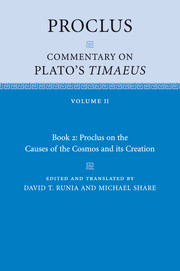Introduction to Book 2
Published online by Cambridge University Press: 30 June 2022
Summary
STRUCTURE OF BOOK 2 OF PROCLUS’ COMMENTARY
Book 2 of Proclus’ Commentary on the Timaeus comments on 27c1–31b4 of the original text, amounting to 106 lines of Greek in Burnet's OCT edition. After two introductory sections, the former recapitulating the role of the prologue in 17a1–27b8, the latter giving a brief exposition on the nature and role of prayer, Proclus divides the text into fifty-one brief lemmata and treats them sequentially in the remainder of the book. The longest lemma is four and a half lines, the shortest are a number of lemmata of about a single line of text. Each lemma is cited in full. Proclus’ text, which antedates that of the earliest manuscripts by at least half a millennium, is remarkably similar to Burnet's text, but there are a few significant differences, such as the omission of αɛí at 28a1. All variations between Proclus’ text and Burnet's are noted in the translation in footnotes to the translated lemma.
The commentary on the fifty-one lemmata takes up 240 pages of Diehl's Teubner text, so averages just under five pages per lemma. The length of the individual sections, however, is quite varied, depending on the subject dealt with. The longest sections are in each case provoked by an important theme, as can be seen in the following table, which lists the seven longest:
Some sections, in contrast, are as short as a single page. It cannot, in fact, be said that the commentary itself has any kind of structure beyond the sequence of cited lemmata and the comments made on them, which are in turn determined by both the method used by Proclus and the subjects raised by the text and its commentator. We shall return to Proclus’ method in the next section.
A different, though not wholly unrelated, question is how Proclus the commentator views the structure of the Platonic text. This is in fact what determines the length of the book. The question is not hugely important for him, and what he says on the matter is not always fully consistent, but he makes enough remarks to enable us to reconstruct his views.
- Type
- Chapter
- Information
- Proclus: Commentary on Plato's Timaeus Volume 2: Book 2: Proclus on the Causes of the Cosmos and its Creation , pp. 1 - 32Publisher: Cambridge University PressPrint publication year: 2008



